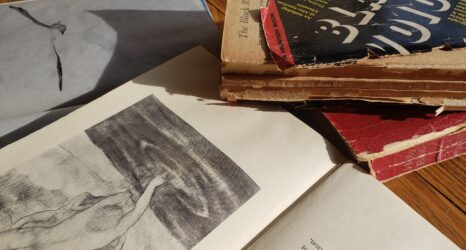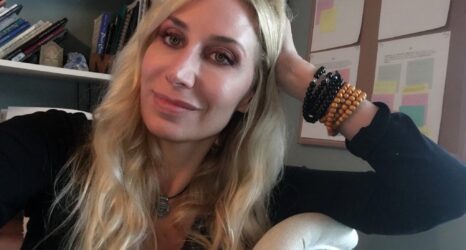Under the gaze of other first grade children eating peanut butter and jelly or Lunchables sandwiches, Christine Sloan Stoddard scraped her Salvadorian mother’s arroz con huevo frito into the trash. Stoddard’s mother, who narrowly escaped El Salvador’s civil war and learned English listening to rock songs, was often mistaken for her nanny; that day, a girl in her class had called her lunch “disgusting.”
Stoddard wrote about that day, and growing up Salvadoran-Scottish-American in suburban Virginia, in the introduction to her nonfiction book Hispanic & Latino Heritage in Virginia—but of all the projects she mentioned to Ms., that wasn’t even one of them.
A prolific writer and visual artist living in Brooklyn, Stoddard was named one of Folio magazine’s top 20 media visionaries in their twenties for founding the woman-run Quail Bell Magazine. She is the author of several books, including Water for the Cactus Woman (Spuyten Duyvil), a collection of bilingual poems and art about mothers and grandmothers, and her writing has appeared in magazines like Marie Claire, Bustle, Teen Vogue and Cosmopolitan. Stoddard is currently pursuing her MFA in Digital & Interdisciplinary Art Practice at The City College of New York.
In this month’s installment of Ms. Muse, Stoddard shares poems from Water for the Cactus Woman and a new poem soon to appear in her forthcoming Belladonna Magic from Shanti Arts and talks to Ms. about the challenges of her childhood, the dissolving wall between literature and the art world and her need to make feminist art in the wake of the Kavanaugh hearings.
The Poems
The Portrait Among Marigolds
Cuando mi abuela tenía 40 años,[1]
she posed for her portrait en la plaza[2]
under the shade of an ochre cathedral
and a set of dying palm trees
skinny as skeletons.
Mami says Abuela fluttered her lashes
for a beloved local artist,
but refused to smile for fear
her dentures would plop out
and land in her fleshy lap.
Today I look at Abuela’s sad eyes—
eyes blacker than jaguar fur—
as they stare at me from the face
of a pastel likeness
that sits on Mami’s dresser.
When I ask, “¿Era una mujer triste?”
Mami’s eyes startle like the eyes
of a jungle cat caught by flashlight.
She pats the dried marigolds
that encircle the portrait
y me dice que todas las mujeres están
tristes de vez en cuando,
pero estar no es ser.[3]
1]When my grandmother was 40 years old
[2] in the town square
[3] and she tells me that all women feel sad sometimes, but feeling is not being.
Saints and Frijoles
The olive tree rosary under my pillow
belonged to mi abuela[1]
and her grasping hands.
Sometimes when the owl cries,
I clutch the rosary until it grows
hot in my palms and glows gold.
“Your abuela’s favorite saint
was Saint Francis of Assisi,”
says Mami while stirring frijoles.
“She believed in the kindness of animals.”
“What about the kindness of humans?”
I ask from my place on the floor
with my picture book Bible before me.
The beans begin to boil over in her silence.
“No, she did not believe in human kindness,”
says Mami después de un rato,[2]
long enough to make me wonder
if Eve thought Adam
a good man.
[1]my grandmother
[2] after a spell
The Storm
No one told me
my body
was an earthquake,
my body
a hurricane,
tornado.
That my body
was and will always be
the eye of the storm.
They only told me
that I was a woman,
that I was to be
placid as a lake—
yet how can I be
human if I never
thunder, if I never rain?
I am wind
and I am hail
just as I am flesh
and I am blood.
This lake will stir.
This lake will flood.
And when it’s placid,
it will hypnotize.
The Interview
Can you tell me about your process of writing “Saints and Frijoles” and “The Portrait Among Marigolds?” What do you remember about the poems’ births?
I remember birthing both poems quickly because the story that they form had been living inside of me for so long. For me, the actual act of writing tends to happen fast, but only because my thoughts brew for so long before I pick up a pen or sit at a keyboard.
What childhood experiences with language informed your relationship with poetry?
I had a speech impediment as a child and went through about four years of speech therapy because of it. Already naturally shy, I generally stayed quiet because speaking could be difficult. In hindsight, much of it was psychological. In front of family or close friends, I could let go of my inhibitions and speak more clearly because I wasn’t so self-conscious.
At the same time that I wrestled with my impediment, I struggled to speak Spanish, my mother’s native language. Again, it was psychological. Classmates bullied me about my mother’s accent and that made me more reluctant to speak Spanish. I didn’t become comfortable with the language until high school, thanks to my wonderful AP Spanish teacher, Señora Barrueta. I became more enthusiastic in college because of a professor, Patricia Michelsen-King, who encouraged me to pursue translation.
I experienced more anxiety about speaking Spanish recently when I visited my mother’s home country of El Salvador for the first time. I didn’t want to sound like an “ugly American.” However, people were surprised when I told them I was American! It was a pleasant reminder of how fluid and expansive language—and people’s perception of language—is and can be.
Do you seek out poetry by women and nonbinary writers? If so, since when and why? More specifically, how has the work of feminist poets mattered in your childhood and/or your life as an adult?
Yes, definitely. I have since middle school when I first identified as a feminist. I even belonged to an all-girls’ science club! In my mother’s culture, there’s so much that women are not allowed to do. The social restrictions are even tighter than they are in the United States. While my mother would be considered conservative by many American parents, she’d be quite progressive in El Salvador because she always told my sisters and me to dream big. She wanted us to finish high school, go to college, have careers, and always read avidly. Such opportunities are not easily accessible to most Salvadoran women. Child marriage was only banned in the country last year. There is no legal abortion in El Salvador. Domestic and gang violence against women is quite prevalent.
Growing up, I was constantly reminded of how lucky I was to be a girl in the United States and not El Salvador. Certainly, that is true from a material perspective and legally. Of course, women and girls suffer from much inequity here in the U.S.
Female writers and artists who inspire me include Shelley Jackson, Moyra Davey, Sally Mann, Julie Chen, Beatriz De Leon, and Stacey Steers.
Gwendolyn Brooks really touched me in high school and today I’m very drawn to the work of Ada Limón. It doesn’t matter that our lives are so different in many ways. Reading poetry by women helps me see the interior lives of other women. Pain unites us, just as the beautiful aspects of womanhood unite us.
What groundbreaking (or ancient) works, forms, ideas and issues in poetry today interest and concern you?
Right now, I’m fascinated by the role of poetry in digital culture and contemporary art. I’m curious about how poetry will evolve on Instagram and other social media. I’m interested in how online literary magazines are changing, too, and feel excited about how poetry is hatching in galleries and museums. The wall between the literary and visual art world seems to be melting.
As a woman, and as a woman who writes, what do you need to support your work? What opportunities, support, policies, and actions can/could make a direct difference for you—and for other women writers you know?
I’m 29 and have been married for three years now. To say that children are on my mind is an understatement. Sadly, our society is not kind to mothers, let alone mothers who are artists. In making plans to have children, I must make plans for healthcare and maternity leave. At the moment, my work is flexible and I appreciate that. I’m starting to build momentum with artist grants, residencies, teaching, and consulting. But what will happen to my career when I have children? Will all of this momentum come to a halt? Will it be financially feasible to scale back? If legislation remains the same, I will have to lean very heavily on my social and professional networks for help finding essentials like childcare, skill shares, and emotional support.
What’s next? What upcoming plans and projects excite you?
Up next is a bevy of books! 2019 will be quite the year. Shanti Arts will publish my poetry and photo collection, Belladonna Magic, a celebration of feminine power and magic. Clash Books will publish Heaven Is A Photograph, another collection of poetry and photography, this one about a young woman who pursues photography in secret, under the shadow of her famous photographer father. About Editions will publish my novella, Naomi & the Reckoning, about a woman whose “purity” culture upbringing haunts her in marriage. Hoot ‘n’ Waddle (born of Four Chambers Press) will publish Desert Fox by the Sea, a collection of short stories. Last but not least, my first children’s book, The Book of Quails, will be released by Clare Songbirds Publishing House. Sami Cronk is the talented artist who illustrated it.
It’s hard to fathom how anyone can have five books coming out in one year. How did you do it?
I was very lucky to have plenty of time to write from 2014-2016. I had residencies and stable, low-key day jobs with a lot of downtime and computer access.
How has the current political climate in the U.S. affected you as a woman writer?
The Kavanaugh debacle ignited me with the same sense of urgency I felt when Trump was elected. I am eager to express myself and desperate to collaborate with like-minded artists and writers. At the moment, I am working on a few collaborative projects, but one really got going because of Kavanaugh. I am completing illustrations for the book Cynthia Silver by Sam Jowett, which will be published by Nadia Gerassimenko of Moonchild Magazine. In truth, I was sitting on this adult fairy tale project for a few months before I picked up a pen and began drawing. Then Kavanaugh was sworn in. More than ever, I wanted to help put out a story with a strong female protagonist.
Other collaborative projects include short films and videos. It was a strange coincidence that Deniz Ataman and I shot “Ghost” the same week that Dr. Ford brought forward her allegations. It’s an Instagram film. My friend Deniz Ataman wrote the script about remembering her Turkish mother and grandmother making and drinking tea. Deniz released the film the first day that now-Justice Kavanaugh took the bench on the Supreme Court. Art is even more necessary in times of crisis.
Chivas Sandage is a digital columnist at Ms. and the author of Hidden Drive, a finalist for the 2012 ForeWord Book of the Year Awards in poetry. Her poems and essays are forthcoming or have appeared in Ms., The Rumpus, Salmagundi, Southern Humanities Review and Texas Observer, among others. She is at work on a nonfiction book about the double shooting of a lesbian teenage couple in Texas. Tweet her @ChivasSandage.





